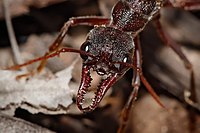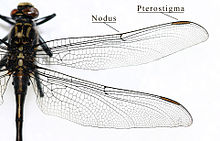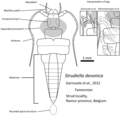Portal:Insects
The Insects Portal


Insects (from Latin insectum) are hexapod invertebrates of the class Insecta. They are the largest group within the arthropod phylum. Insects have a chitinous exoskeleton, a three-part body (head, thorax and abdomen), three pairs of jointed legs, compound eyes, and a pair of antennae. Insects are the most diverse group of animals, with more than a million described species; they represent more than half of all animal species. (Full article...)
Selected article -
Insect wings are adult outgrowths of the insect exoskeleton that enable insects to fly. They are found on the second and third thoracic segments (the mesothorax and metathorax), and the two pairs are often referred to as the forewings and hindwings, respectively, though a few insects lack hindwings, even rudiments. The wings are strengthened by a number of longitudinal veins, which often have cross-connections that form closed "cells" in the membrane (extreme examples include the dragonflies and lacewings). The patterns resulting from the fusion and cross-connection of the wing veins are often diagnostic for different evolutionary lineages and can be used for identification to the family or even genus level in many orders of insects.
Physically, some insects move their flight muscles directly, others indirectly. In insects with direct flight, the wing muscles directly attach to the wing base, so that a small downward movement of the wing base lifts the wing itself upward. Those insects with indirect flight have muscles that attach to and deform the thorax, causing the wings to move as well. (Full article...)Did you know -
- ... that species in the fossil ant genus Myrmeciites are named for Hercules, Goliath, and a river?
- ... that Euploea alcathoe, the common crow butterfly, may pass through several generations in a year?
- ... that the female sand wasp Ammophila sabulosa digs burrows in sandy ground, provisioning each burrow with a food supply of paralysed caterpillars, always laying one egg on the first caterpillar?
- ... that larvae of the toadfly make their way through the nostrils of the common toad and eat its flesh?
- ... that the rice stink bug, a major pest of rice kernels, can possibly be ignored when found on standing maize?
List articles
Related portals
General images -
Selected image -

Gryllotalpa brachyptera is a mole cricket (Orthoptera: Gryllotalpidae), native to Australia. Mole crickets are thick-bodied insects about 3–5 cm (1.2–2.0 in) long, with large beady eyes and shovel-like forelimbs highly developed for burrowing and swimming. The adult mole cricket may fly as far as 8 kilometres (5.0 mi) during the mating season, is active most of the year, and spends the winter in hibernation.
WikiProjects

Main WikiProject:
Related projects:
- WikiProject Arthropods
- WikiProject Spiders
- WikiProject Animals
- WikiProject Tree of Life
- WikiProject Biology
Daughter projects:
Tasks
 |
Here are some tasks awaiting attention:
|
Associated Wikimedia
The following Wikimedia Foundation sister projects provide more on this subject:
-
Commons
Free media repository -
Wikibooks
Free textbooks and manuals -
Wikidata
Free knowledge base -
Wikinews
Free-content news -
Wikiquote
Collection of quotations -
Wikisource
Free-content library -
Wikiversity
Free learning tools -
Wiktionary
Dictionary and thesaurus




















































